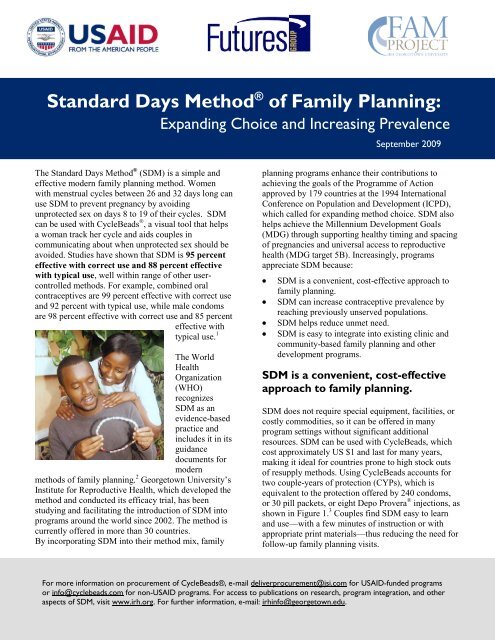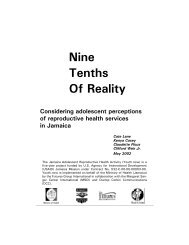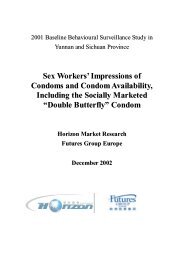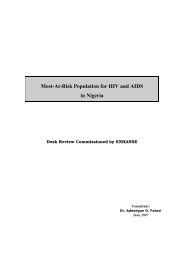3541FAM-SDM PolicyBrief.pdf - Futures Group
3541FAM-SDM PolicyBrief.pdf - Futures Group
3541FAM-SDM PolicyBrief.pdf - Futures Group
You also want an ePaper? Increase the reach of your titles
YUMPU automatically turns print PDFs into web optimized ePapers that Google loves.
Standard Days Method ® of Family Planning:<br />
Expanding Choice and Increasing Prevalence<br />
September 2009<br />
The Standard Days Method ® (<strong>SDM</strong>) is a simple and<br />
effective modern family planning method. Women<br />
with menstrual cycles between 26 and 32 days long can<br />
use <strong>SDM</strong> to prevent pregnancy by avoiding<br />
unprotected sex on days 8 to 19 of their cycles. <strong>SDM</strong><br />
can be used with CycleBeads ® , a visual tool that helps<br />
a woman track her cycle and aids couples in<br />
communicating about when unprotected sex should be<br />
avoided. Studies have shown that <strong>SDM</strong> is 95 percent<br />
effective with correct use and 88 percent effective<br />
with typical use, well within range of other usercontrolled<br />
methods. For example, combined oral<br />
contraceptives are 99 percent effective with correct use<br />
and 92 percent with typical use, while male condoms<br />
are 98 percent effective with correct use and 85 percent<br />
effective with<br />
typical use. 1<br />
The World<br />
Health<br />
Organization<br />
(WHO)<br />
recognizes<br />
<strong>SDM</strong> as an<br />
evidence-based<br />
practice and<br />
includes it in its<br />
guidance<br />
documents for<br />
modern<br />
methods of family planning. 2 Georgetown University’s<br />
Institute for Reproductive Health, which developed the<br />
method and conducted its efficacy trial, has been<br />
studying and facilitating the introduction of <strong>SDM</strong> into<br />
programs around the world since 2002. The method is<br />
currently offered in more than 30 countries.<br />
By incorporating <strong>SDM</strong> into their method mix, family<br />
planning programs enhance their contributions to<br />
achieving the goals of the Programme of Action<br />
approved by 179 countries at the 1994 International<br />
Conference on Population and Development (ICPD),<br />
which called for expanding method choice. <strong>SDM</strong> also<br />
helps achieve the Millennium Development Goals<br />
(MDG) through supporting healthy timing and spacing<br />
of pregnancies and universal access to reproductive<br />
health (MDG target 5B). Increasingly, programs<br />
appreciate <strong>SDM</strong> because:<br />
<br />
<br />
<br />
<br />
<strong>SDM</strong> is a convenient, cost-effective approach to<br />
family planning.<br />
<strong>SDM</strong> can increase contraceptive prevalence by<br />
reaching previously unserved populations.<br />
<strong>SDM</strong> helps reduce unmet need.<br />
<strong>SDM</strong> is easy to integrate into existing clinic and<br />
community-based family planning and other<br />
development programs.<br />
<strong>SDM</strong> is a convenient, cost-effective<br />
approach to family planning.<br />
<strong>SDM</strong> does not require special equipment, facilities, or<br />
costly commodities, so it can be offered in many<br />
program settings without significant additional<br />
resources. <strong>SDM</strong> can be used with CycleBeads, which<br />
cost approximately US $1 and last for many years,<br />
making it ideal for countries prone to high stock outs<br />
of resupply methods. Using CycleBeads accounts for<br />
two couple-years of protection (CYPs), which is<br />
equivalent to the protection offered by 240 condoms,<br />
or 30 pill packets, or eight Depo Provera ® injections, as<br />
shown in Figure 1. 3 Couples find <strong>SDM</strong> easy to learn<br />
and use—with a few minutes of instruction or with<br />
appropriate print materials—thus reducing the need for<br />
follow-up family planning visits.<br />
For more information on procurement of CycleBeads®, e-mail deliverprocurement@jsi.com for USAID-funded programs<br />
or info@cyclebeads.com for non-USAID programs. For access to publications on research, program integration, and other<br />
aspects of <strong>SDM</strong>, visit www.irh.org. For further information, e-mail: irhinfo@georgetown.edu.
Figure 1. Supplies needed for two couple-years<br />
of protection<br />
<strong>SDM</strong> helps reduce unmet need.<br />
Adapted from USAID Office of Sustainable Development, Bureau for<br />
Africa, Health and Family Planning Indicators Volume I, July 1999.<br />
<strong>SDM</strong> can increase contraceptive<br />
prevalence by reaching previously<br />
unserved populations.<br />
Research shows that the primary users of <strong>SDM</strong> are<br />
women who had never previously used another modern<br />
family planning method. Figure 2 shows the results<br />
from a study that examined the profiles of <strong>SDM</strong> users<br />
in five countries and found that between 60 percent of<br />
women (India-rural) and 81 percent of women (Benin)<br />
in the study had never used modern family planning. 4<br />
Among <strong>SDM</strong> users who had previously used a method,<br />
most had not used any method in the previous several<br />
months. By offering <strong>SDM</strong>, programs can reach those<br />
who may not initiate or may not continue using other<br />
methods.<br />
“[In Mali]…in addition to training providers in<br />
health facilities, community-based providers were<br />
also trained [on <strong>SDM</strong>]. This helps respond to the<br />
high level of unmet need for family planning at the<br />
community level, which is estimated to be 29<br />
percent.”<br />
—Dr. Binta Keita, Ministry of Health, Mali<br />
Reducing unmet need for family planning<br />
remains a challenge for family planning and<br />
reproductive health programs. According to<br />
Demographic and Health Surveys, 130 million<br />
married women in developing countries who<br />
want to delay or avoid pregnancy are not using<br />
family planning. The most common reason<br />
women give for not using contraception is fear<br />
of side effects and health complications. 5<br />
Others find most methods to be too costly or<br />
difficult to obtain. <strong>SDM</strong> attracts new users to<br />
the practice of family planning because it is an<br />
effective, low-cost method to avoid unplanned<br />
pregnancies with no health side effects. 6 In<br />
addition, while most of these women continue<br />
using <strong>SDM</strong> for years, some eventually switch to<br />
other modern methods.<br />
<strong>SDM</strong> is easy to integrate into existing<br />
clinic and community-based family<br />
planning and other development<br />
programs.<br />
Family planning programs and community networks in<br />
more than 30 countries have integrated <strong>SDM</strong><br />
successfully into their array of contraceptive methods.<br />
Training requirements for providers are minimal; as<br />
little as two hours of training is necessary to prepare<br />
family planning providers to offer <strong>SDM</strong>. 7 <strong>SDM</strong> can be<br />
offered by public sector clinics and outreach programs,<br />
family planning associations, pharmacies, and private<br />
clinics, as well as through non-traditional channels,<br />
such as faith-based organizations, women’s<br />
associations, and agricultural cooperatives. For<br />
example, in Rwanda, where 9,000 women currently<br />
use <strong>SDM</strong>, it was first introduced in public health<br />
clinics, clinics run by religious organizations, and<br />
nongovernmental organization (NGO) sites. <strong>SDM</strong> is<br />
also easily integrated into existing programs because<br />
CycleBeads are included in the USAID contraceptive<br />
and reproductive health commodity procurement<br />
system. This makes it more feasible for country<br />
programs to include <strong>SDM</strong> as a contraceptive option.
Figure 2. Percentage of <strong>SDM</strong> users who had<br />
never used a modern family planning method<br />
bringing new users to family planning, thereby lowering<br />
fertility rates and improving health outcomes.<br />
Recommended steps for integrating <strong>SDM</strong> into country<br />
programs include:<br />
Policy Recommendations<br />
Expanding a country’s method mix to include <strong>SDM</strong> can<br />
help achieve national health and development goals by<br />
<br />
<br />
<br />
<br />
<br />
<br />
Ensuring that <strong>SDM</strong> is part of national family<br />
planning norms and reproductive health plans;<br />
Including <strong>SDM</strong> in reporting systems;<br />
Including <strong>SDM</strong> in training of health providers as<br />
well as in pre-service and continuing education;<br />
Increasing awareness of <strong>SDM</strong> through mass media<br />
and other communication strategies;<br />
Including CycleBeads in procurement and logistics<br />
systems for health-related commodities; and<br />
Offering CycleBeads within health facilities, family<br />
planning networks, pharmacies, and through<br />
community groups.<br />
1 World Health Organization Department of Reproductive<br />
Health and Research (WHO/RHR) and Johns Hopkins<br />
Bloomberg School of Public Health/Center for Communication<br />
Programs (CCP), INFO Project. Family Planning: A Global<br />
Handbook for Providers (2008 update). Baltimore and Geneva:<br />
CCP and WHO, 2008. See also Arévalo M, Jennings V, Sinai I.<br />
2002. Efficacy of a New Method of Family Planning: the<br />
Standard Days Method. Contraception: 65:333-338.<br />
2 World Health Organization. Medical Eligibility Criteria for<br />
Contraceptive Use (2004) , Selected Practice Recommendations<br />
for Contraceptive Use (2005) , Decision-Making Tool for Family<br />
Planning Clients and Providers (2005), Family Planning: A Global<br />
Handbook for Providers (2007).<br />
3 USAID and AED. 1999. Health and Family Planning Indicators:<br />
A Tool for Results Frameworks, Volume 1. Washington, DC:<br />
USAID, Africa Bureau’s Office of Sustainable Development<br />
(AFR/SD) and Academy for Educational Development’s SARA<br />
Project.<br />
4 Long-Term Use of Standard Days Method®: Experience of<br />
Operations Research Study Participants. February 2008.<br />
Washington, D.C.: Institute for Reproductive Health,<br />
Georgetown University for the U.S. Agency for International<br />
Development (USAID).<br />
5 Ashford, Lori. 2003. Unmet need for family planning: Recent<br />
trends and their implications for programs. Washington DC:<br />
Population Reference Bureau.<br />
6 Gribble, J, et al. 2008. Being strategic about contraceptive<br />
introduction: The experience of the Standard Days Method.<br />
Contraception: 77: 147-154.<br />
7 Gribble J, et al. 2004. Mind the gap: responding to the global<br />
funding crisis in family planning. Journal of Family Planning<br />
and Reproductive Health Care: 30(3):155-157.<br />
Institute for Reproductive Health<br />
Georgetown University<br />
4301 Connecticut Ave, NW Suite 310<br />
Washington, DC 20008<br />
Tel: 202-687-1392<br />
www.irh.org<br />
Using evidence to expand choice, empower women, and involve communities







